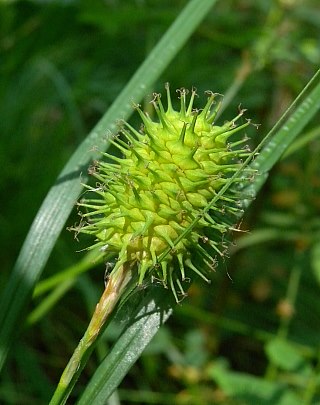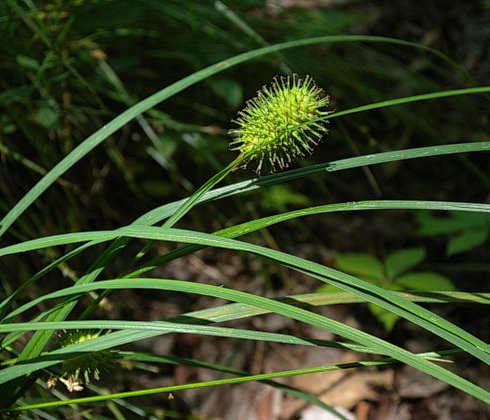
Each fertile culm terminates in an inflorescence consisting of a single terminal spike on a short erect peduncle and a leafy bract at the base of the peduncle. Alternatively, an inflorescence may have 2-3 spikes in an inflorescence, but this is highly unusual. The main body of the spike is ¾-1½" long, ½-¾" across, and broadly cylindrical in shape. All around this portion of the spike, 80 or more perigynia are packed densely together; the beaks of the perigynia point upward at the top of the spike, they point outward toward the middle of the spike, and they point downward at the bottom of the spike. The bodies of the perigynia are 4-5 mm. in length and 2-3 mm. across, while their narrow beaks are 2.5-3.0 mm. long. The bodies of the perigynia are oblanceolate to obovoid in shape, slightly compressed (flattened), glabrous, and longitudinally veined (the veins are usually obscure). The pistillate scales are 3-4 mm. in length, 1 mm. across., narrowly lanceolate to narrowly oblanceolate, tapering to acute tips; they are green-veined in the middle and membranous along their margins. In contrast to the main body of the spike, the bottom of each spike is
Cultivation: This sedge adapts to light shade or partial sun, wet to moist conditions, and soil containing loam, silt, sand, or gravel. Shallow standing water is tolerated if it is seasonal and temporary, rather than permanent.
Range & Habitat: Squarrose Sedge is fairly common in southern Illinois, while in central and northern Illinois it is uncommon. Habitats include wet areas of bottomland woodlands, prairie swales, swamps, sedge meadows, and gravelly seeps. This sedge usually occurs in shaded or partially shaded areas of wetlands. Less often, it can be found in wet sunny areas.
Faunal Associations: Sedges (Carex spp.) are ubiquitous in wetland areas and many insects are adapted to feed on them in these habitats. These species include leaf beetles (primarily Plateumaris spp.), Sphenophorus costicollis (Sedge Billbug), seed bugs (Lygaeidae), plant bugs (Miridae), the shield bug Eurygaster alternata, aphids and leafhoppers, stem-boring larvae of flies, caterpillars of moths and skippers, caterpillars of the butterflies Satyrodes eurydice (Eyed Brown) and Satyrodes appalachia (Appalachian Brown), and sedge grasshoppers (Stethophyma spp.). The Insect Table lists many of these species. Some vertebrate animals also use wetland sedges as a source of food. Ducks, rails, and other wetland birds feed on the seeds or spikelets (see Bird Table), while such turtles as Chelydra serpentina (Snapping Turtle) and Kinosternum subrubrum (Eastern Mud Turtle) feed on the spikelets or foliage (Ernst et al., 1994). Among mammals, muskrats eat the culms, roots, or sprouts of wetland sedges occasionally, while such mammals as the White-Tailed Deer and Black Bear feed on the foliage or spikelets very sparingly.
Photographic Location: A sandy swamp at the Indiana Dunes State Park in NW Indiana.

Comments: Many wetland sedges (Carex spp.) have large spikelets with inflated perigynia. While almost all of these sedges have 2 or more spikelets per inflorescence, Squarrose Sedge is highly unusual in having only a single terminal spike in its inflorescence (for this species, 2-3 spikelets can occur in an inflorescence, but this happens rarely). The only other sedge in Illinois that closely resembles it, Cattail Sedge (Carex typhina), often produces 2-4 spikelets per inflorescence, instead of a single terminal spike. The terminal spike or spikelet of Cattail Sedge has staminate florets and scales at its bottom and sometimes at its apex. In contrast, the terminal spike of Squarrose Sedge never produces staminate florets and scales at its apex. In addition, Cattail Sedge differs from Squarrose Sedge in the following characteristics: 1) its leaf blades are more wide (up to 10 mm. across), 2) the beaks of the lower perigynia of its spikelets usually point outward rather than downward, and 3) its achenes are shorter (2.0-2.5 mm. in length) and less elongated in shape. Another species that is somewhat similar, Carex frankii (Frank's Sedge), produces multiple spikelets per inflorescence and its pistillate scales are much longer (up to 10 mm. in length) and more conspicuous.